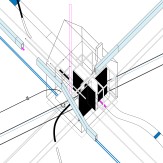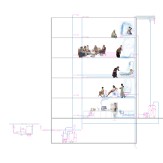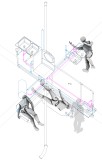MASTER OF SCIENCE IN ARCHITECTURE FALL 2021
GRADUATE RESEARCH DESIGN STUDIO I
Guido Zuliani, Distinguished Professor Adjunct
DWELLING
DOMESTIC << + >> COLLECTIVE
COMMUNAL
This studio confronted the necessary redefinition of architecture, of its objectives and means, that current socio-environmental crises demand. The work of the studio focused on domestic space understood in the most expansive sense and as the starting point for generating and exploring architectural ideas and strategies for producing more equitable forms of dwelling in the urban environment, and a more equitable urban environment itself.
Sebastiano Serlio’s On the Habitations for Man of All Levels, compiled around 1555, together with a following volume dedicated to Roman military camps, constitute the first veritable urbanist manual. In them Serlio recognized the centrality of domestic architecture in the efficient organization of the emerging proto-capitalistic city. On the Habitations offers a catalogue of dwellings based on a socio-economic classification of all components of urban society: proletarian and low-level workers, merchants, civil and military functionaries, aristocrats, and kings. Serlio’s objective is made explicit in his follow-up volume, De Castrametation, where the functional, hierarchical organization of the Roman military camp is taken as the blueprint of a rational urban organization that, in clearly recognizing the class structure of the urban space, aspired to regulate and organize its differences and possible conflicts, and is the explicit expression of an early form of biopolitcs.
Moving forward: in the late 19th and 20th century the effects of the Industrial Revolution, with its exigences of rationalization and division of labor, and the search for an ever-increasing efficiency of its exploitation, reached into the domestic space. Here, it consolidated its heteropatriarchal nature as the locus of unpaid female labor perfectly integrated within the industrial cycle of production as the agency of the re-production of the labor force. Within this optic the architectural avant-garde of the 1920s conceived the individual dwelling in the form of an industrial component complementing the activity of the factory, and a must-be-efficient productive apparatus in its own right. This scientific approach to the definition of the modalities of life itself via the definition of the organization of domestic space found a broader, more detailed, articulate and ultimately normalized definition in the work of Ernst Neufert and his Architects’ Data.
Today, not only the advent of digital technology—both in the realm of production as well as in the field of design—but also the emerging awareness of the origin and perpetuation of the socio-political nature of domestic space, have radically altered, respectively, the organization of the working environment and the way in which we occupy our living spaces, with their boundaries made uncertain and their limits porous by our simultaneous involvement within a multiplicity of social realms, physical and virtual. Domestic spaces, their definition and their organizations, have at the same time revealed their nature as contested spaces— continuously traversed and defined by the intersecting politics of gender, race, and class intrinsic to the capitalist economy, and the locus of possible resistance to it.
The objective of this studio was to develop research and experimentation directed to a radical rethinking of the nature and form(s) of the architecture of domestic space understood in the most expansive sense. The aim was to produce possible new concepts and typologies of residential organizations, of living spaces, starting from critical reflections on the nature and transformations of the domestic space and eventually considering the concept of communal space as an intermediary between the private and the collective realm.
The aim of these explorations, which take the critique of Neufert’s manual as a possible heuristic starting point, does not necessarily amount to the design of a complete dwelling, or dwellings, but possibly to a new taxonomy—an open-ended series of conceptual, graphic, and physical representations offering multiple understanding of our living spaces and new potentials for their definition and aggregations. In this sense the production of drawings, collages, models, films, etc., must consider the specific language through which the research is conducted and the architectural ideas are articulated.



















